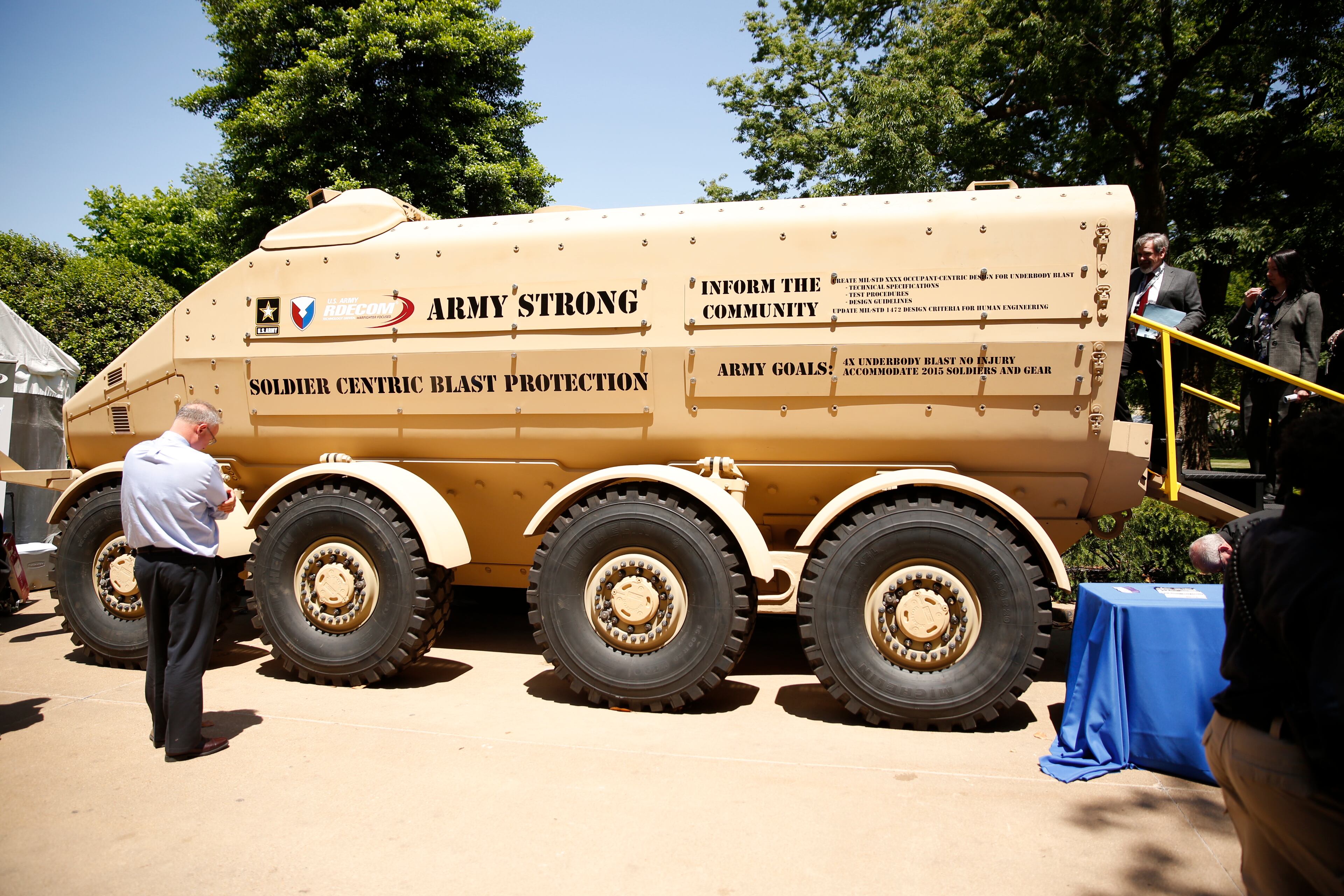The tinkerers imagining and putting together the military's new toys got a chance for show-and-tell Thursday.
Over More than 100 display booths sprouted up in the Pentagon courtyard for the first-ever Defense Department Lab Day, an event designed to showcase the department's research and development work.
All of the services had representation on hand, with technologies in different stages of development. The smorgasbord of concepts included missile systems, various threat detection capabilities, flight control systems and airplane engines, vehicle and personal protection from explosions, communications systems and more — right down to samples of the long-awaited MRE pizza.
"It's an opportunity to see all the great things going on in our labs. I'm in awe every day," said Alan Shaffer, principal deputy assistant secretary of defense for research engineering , to a crowd ranging from DoD personnel and Ccongressional staff to high school students.
, to a crowd ranging from DoD personnel and Ccongressional staff to high school students.

Samples of the new shelf-stable MRE pizza were offered up May 14 at the Department of Defense Lab Day at the Pentagon.
Photo Credit: Mike Morones/Staff
While private companies develop a lot of the technologies implemented in Defense Department systems, Shaffer said DoD labs are essential to adapting industry to solve military problems.
• Some prototypes, such as the Concept for Advanced Military Explosion-mitigating Land Demonstrator, on display Thursday, aren't even necessarily intended for the field. The CAMEL, an 11-man personnel carrier that isn't driveable, has been a tool for the Tank Automotive Research Development Engineering Center.
It has largely been tested for resistance to explosives and accommodating soldiers and their gear — without twisting them into a pretzel, Korson said.

The Concept for Advanced Military Explosion-mitigating Land Demonstrator, or CAMEL, was on display May 14 at the inaugural Department of Defense Lab Day at the Pentagon in Arlington, Va.
Photo Credit: Mike Morones/Staff
- The Serenity sensor system pairs audio detectors, infrared and eight high-resolution cameras that can quickly pinpoint the location of an enemy attack from any side of a forward operating base. David Anderson,
 a contractor who works with Army Research Laboratory and Aviation and Missile Research, Development and Engineering Center, said it's well-tested and ready to see action.
a contractor who works with Army Research Laboratory and Aviation and Missile Research, Development and Engineering Center, said it's well-tested and ready to see action.
- Other gear on display has already been fielded, though some of it in limited fashion. The Army had a station for a fuel-cell powered UAV that can stay in the air for eight hours. According to Josh McClure, an ARL scientist working on the project, it has flown 80 missions in the field, three-quarters of them lasting over four hours. Aside from longer-sustained missions advantages include extended range and fewer potentially-damaging landings.
- The Navy had a station for its newly-tested MAGIC CARPET flight control, which offers augmented control modes intended to simply carrier landings.
Other items on display:
The Air Force showed off a variety of advances in BATMAN, its program to improve the equipping of dismounted airmen with a wide range of technologies.
- A variety of medical devices were on display, from training tools to health-monitoring sensors. There was also a display laying out military laboratories' contributions in battling the Ebola outbreak on West Africa.
- A foliage detection system on display detected enemy movement through more than 200 meters of foliage in testing, a significant upgrade over currently available technology.
- The Degraded Visual Environment Mitigation program — a sort of night vision that can allow helicopters to fly through fog, smoke and dust — would not only "make any day a good day to fight," as AMRDEC's tech lead on the project, Kristopher Kuck, put it. Army helicopters could intentionally kick up a cloud of dust and fly low, in a tight formation, to evade or confound the enemy. Pilots could use radar, laser detection systems and other coordinating technologies to keep from crashing through the haze.
- A magnetic-wheeled robot can climb up metal walls, which could have particularly helpful applications on ships, whether assessing the deck before boarding or simply conducting maintenance.
- Tunnel detection technology that would enable service members to detect enemies that are tunneling or have made tunnels.
- The Navy had a man donning an exoskeleton called an Industrial Human Augmentation System that reinforced the legs and gave an extended robot-arm tool.
- Those MRE pizzas? Now that shelf-life problems with the sauce have been addressed, troops should see them by 2017.





